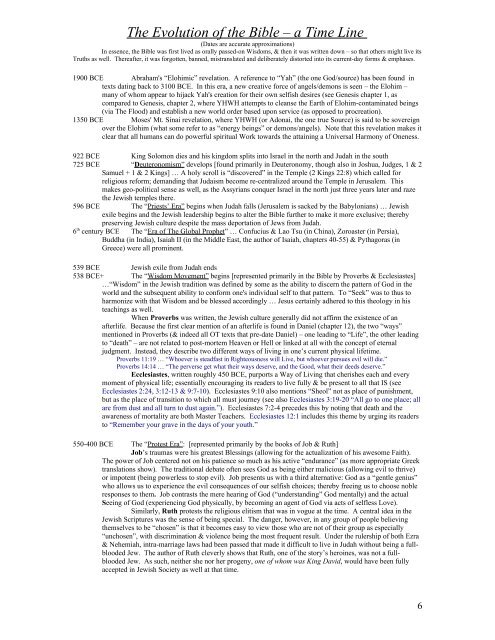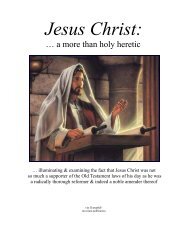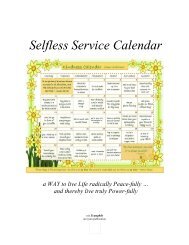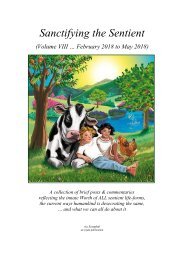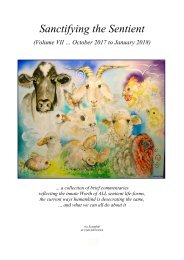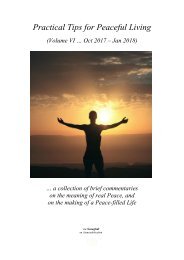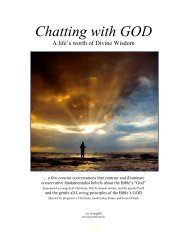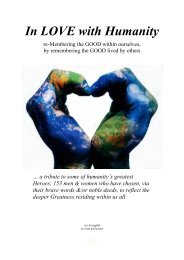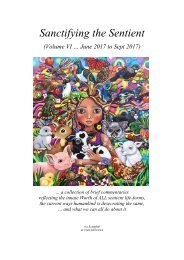3rd Covenant -- presentation pamphlet
Re-Discovering the Word of God within the words of the Bible; Re-Discovering The Way within the Life of Jesus Christ
Re-Discovering the Word of God within the words of the Bible;
Re-Discovering The Way within the Life of Jesus Christ
Create successful ePaper yourself
Turn your PDF publications into a flip-book with our unique Google optimized e-Paper software.
The Evolution of the Bible – a Time Line<br />
(Dates are accurate approximations)<br />
In essence, the Bible was first lived as orally passed-on Wisdoms, & then it was written down – so that others might live its<br />
Truths as well. Thereafter, it was forgotten, banned, mistranslated and deliberately distorted into its current-day forms & emphases.<br />
1900 BCE Abraham's “Elohimic” revelation. A reference to “Yah” (the one God/source) has been found in<br />
texts dating back to 3100 BCE. In this era, a new creative force of angels/demons is seen – the Elohim –<br />
many of whom appear to hijack Yah's creation for their own selfish desires (see Genesis chapter 1, as<br />
compared to Genesis, chapter 2, where YHWH attempts to cleanse the Earth of Elohim-contaminated beings<br />
(via The Flood) and establish a new world order based upon service (as opposed to procreation).<br />
1350 BCE Moses' Mt. Sinai revelation, where YHWH (or Adonai, the one true Source) is said to be sovereign<br />
over the Elohim (what some refer to as “energy beings” or demons/angels). Note that this revelation makes it<br />
clear that all humans can do powerful spiritual Work towards the attaining a Universal Harmony of Oneness.<br />
922 BCE King Solomon dies and his kingdom splits into Israel in the north and Judah in the south<br />
725 BCE “Deuteronomism” develops [found primarily in Deuteronomy, though also in Joshua, Judges, 1 & 2<br />
Samuel + 1 & 2 Kings] … A holy scroll is “discovered” in the Temple (2 Kings 22:8) which called for<br />
religious reform; demanding that Judaism become re-centralized around the Temple in Jerusalem. This<br />
makes geo-political sense as well, as the Assyrians conquer Israel in the north just three years later and raze<br />
the Jewish temples there.<br />
596 BCE The “Priests’ Era” begins when Judah falls (Jerusalem is sacked by the Babylonians) … Jewish<br />
exile begins and the Jewish leadership begins to alter the Bible further to make it more exclusive; thereby<br />
preserving Jewish culture despite the mass deportation of Jews from Judah.<br />
6 th century BCE The “Era of The Global Prophet” … Confucius & Lao Tsu (in China), Zoroaster (in Persia),<br />
Buddha (in India), Isaiah II (in the Middle East, the author of Isaiah, chapters 40-55) & Pythagoras (in<br />
Greece) were all prominent.<br />
539 BCE Jewish exile from Judah ends<br />
538 BCE+ The “Wisdom Movement” begins [represented primarily in the Bible by Proverbs & Ecclesiastes]<br />
…“Wisdom” in the Jewish tradition was defined by some as the ability to discern the pattern of God in the<br />
world and the subsequent ability to conform one's individual self to that pattern. To “Seek” was to thus to<br />
harmonize with that Wisdom and be blessed accordingly … Jesus certainly adhered to this theology in his<br />
teachings as well.<br />
When Proverbs was written, the Jewish culture generally did not affirm the existence of an<br />
afterlife. Because the first clear mention of an afterlife is found in Daniel (chapter 12), the two “ways”<br />
mentioned in Proverbs (& indeed all OT texts that pre-date Daniel) – one leading to “Life”, the other leading<br />
to “death” – are not related to post-mortem Heaven or Hell or linked at all with the concept of eternal<br />
judgment. Instead, they describe two different ways of living in one’s current physical lifetime.<br />
Proverbs 11:19 … “Whoever is steadfast in Righteousness will Live, but whoever pursues evil will die.”<br />
Proverbs 14:14 … “The perverse get what their ways deserve, and the Good, what their deeds deserve.”<br />
Ecclesiastes, written roughly 450 BCE, purports a Way of Living that cherishes each and every<br />
moment of physical life; essentially encouraging its readers to live fully & be present to all that IS (see<br />
Ecclesiastes 2:24, 3:12-13 & 9:7-10). Ecclesiastes 9:10 also mentions “Sheol” not as place of punishment,<br />
but as the place of transition to which all must journey (see also Ecclesiastes 3:19-20 “All go to one place; all<br />
are from dust and all turn to dust again.”). Ecclesiastes 7:2-4 precedes this by noting that death and the<br />
awareness of mortality are both Master Teachers. Ecclesiastes 12:1 includes this theme by urging its readers<br />
to “Remember your grave in the days of your youth.”<br />
550-400 BCE The “Protest Era”: [represented primarily by the books of Job & Ruth]<br />
Job’s traumas were his greatest Blessings (allowing for the actualization of his awesome Faith).<br />
The power of Job centered not on his patience so much as his active “endurance” (as more appropriate Greek<br />
translations show). The traditional debate often sees God as being either malicious (allowing evil to thrive)<br />
or impotent (being powerless to stop evil). Job presents us with a third alternative: God as a “gentle genius”<br />
who allows us to experience the evil consequences of our selfish choices; thereby freeing us to choose noble<br />
responses to them. Job contrasts the mere hearing of God (“understanding” God mentally) and the actual<br />
Seeing of God (experiencing God physically, by becoming an agent of God via acts of selfless Love).<br />
Similarly, Ruth protests the religious elitism that was in vogue at the time. A central idea in the<br />
Jewish Scriptures was the sense of being special. The danger, however, in any group of people believing<br />
themselves to be “chosen” is that it becomes easy to view those who are not of their group as especially<br />
“unchosen”, with discrimination & violence being the most frequent result. Under the rulership of both Ezra<br />
& Nehemiah, intra-marriage laws had been passed that made it difficult to live in Judah without being a fullblooded<br />
Jew. The author of Ruth cleverly shows that Ruth, one of the story’s heroines, was not a fullblooded<br />
Jew. As such, neither she nor her progeny, one of whom was King David, would have been fully<br />
accepted in Jewish Society as well at that time.<br />
6


